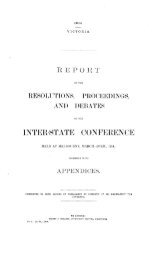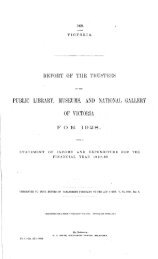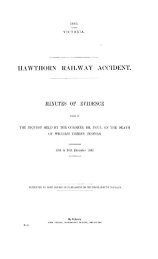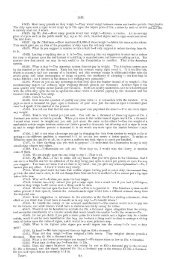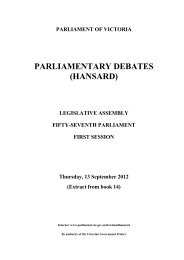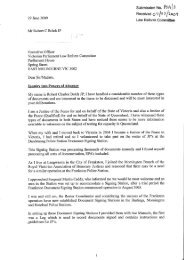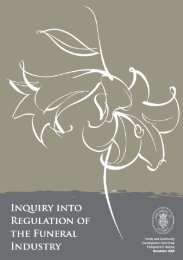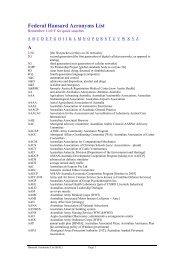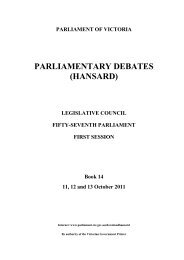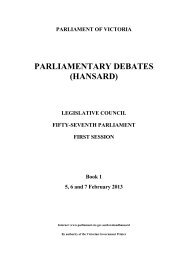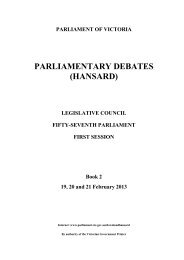Book 8 - Parliament of Victoria
Book 8 - Parliament of Victoria
Book 8 - Parliament of Victoria
Create successful ePaper yourself
Turn your PDF publications into a flip-book with our unique Google optimized e-Paper software.
FLOODS: WATER STORAGE MONITORING<br />
1650 COUNCIL Wednesday, 1 June 2011<br />
There would still have been a large flood, but it would<br />
not have been the record-breaking flood if, over the<br />
space <strong>of</strong> a few weeks, water could have been released<br />
from the dam. That lead to calls not only for the<br />
lowering but also the changing <strong>of</strong> the operating rules<br />
for Lake Eppalock.<br />
At first Goulburn-Murray Water stated it was awaiting<br />
the outcome <strong>of</strong> the Comrie review, but when the<br />
Comrie review indicated it would not be doing specific<br />
work in that area, although it would consult some<br />
independent hydrologists, we later heard the local<br />
member in the Assembly, Paul Weller, calling for some<br />
work in this area. That was followed by Peter Walsh<br />
making some sort <strong>of</strong> announcement that<br />
Goulburn-Murray Water would conduct a review. An<br />
ABC report <strong>of</strong> 9 February quotes Mr Walsh as saying:<br />
As a result <strong>of</strong> the constant rain events … Goulburn-Murray<br />
Water will be looking at the operating rules, just to ensure<br />
they are still appropriate …<br />
I have had a great deal <strong>of</strong> difficulty gaining from<br />
Goulburn-Murray Water any understanding <strong>of</strong> how this<br />
review is progressing or what it will consist <strong>of</strong>.<br />
Naturally irrigators and other owners <strong>of</strong> water will<br />
argue, ‘That is our water’, but the degree <strong>of</strong> impact <strong>of</strong> a<br />
lower operating level depends a bit on the type <strong>of</strong><br />
events we are talking about. If a small proportion <strong>of</strong><br />
excess flows were being released in only those most<br />
extreme years and only in the most extreme<br />
circumstances, then we might not really be losing very<br />
much water at all. The cost benefit <strong>of</strong> that, vis-a-vis the<br />
flooding <strong>of</strong> Rochester and downstream communities<br />
every 10 years or so, as a more cautious approach might<br />
prove to be preferable to how it is being operated at the<br />
moment, which is for the greatest possible storage <strong>of</strong><br />
irrigators’ water and to a certain extent <strong>of</strong> water that is<br />
allocated to Bendigo.<br />
In any case the minister has recognised the need for a<br />
review <strong>of</strong> that storage, but storages right around the<br />
state are quite full as I speak. Of the Yarra storages,<br />
only the Thomson is about half full; most <strong>of</strong> the others<br />
are close to 100 per cent full. The Upper Yarra is at<br />
60 per cent, Sugarloaf is at 95 per cent, Silvan is at<br />
86 per cent, Tarago is at 66 per cent, Yan Yean is at<br />
89 per cent, Greenvale is at 76 per cent and Maroondah<br />
and O’Shannassy are at 100 per cent. I am not<br />
suggesting that it is the Yarra catchment that is at most<br />
risk <strong>of</strong> severe flooding; I am simply trying to create a<br />
complete picture.<br />
The information from the Southern Rural Water area<br />
last week as storages were still rising was: Glenmaggie<br />
at 81 per cent, Blue Rock at 97 per cent, Melton full,<br />
Merrimu full, Narracan full, Pykes Creek full and<br />
Rosslynne full. In the Goulburn-Murray Water area the<br />
figures were: Dartmouth at 63 per cent, Hume at 93 per<br />
cent, Yarrawonga Weir at 53 per cent and Torrumbarry<br />
at 92 per cent. The group around Kerang were at<br />
between 60 and 95 per cent capacity: Lake Buffalo was<br />
at 50 per cent, Lake William Hovell at 100 per cent,<br />
Nillahcootie at 99 per cent, Eildon itself at 84 per cent,<br />
Goulburn Weir at 100 per cent, Waranga at 80 per cent,<br />
Greens Lake at 70 per cent, Eppalock at 97.2 per cent,<br />
Cairn Curran at 89 per cent and Tullaroop at 99 per<br />
cent. Laanecoorie — there are big problems down there<br />
because the gates are broken — is down to 36 per cent,<br />
and Newlyn and Hepburn are both over 100 per cent.<br />
Collectively those are our major storages on regulated<br />
rivers, and I am asking for a review. I am not specifying<br />
how big that review should be or what form it should<br />
take; I am simply asking someone in the area <strong>of</strong><br />
responsibility as a matter <strong>of</strong> risk management to look at<br />
what changes to operating rules might be contemplated<br />
that would minimise the chance <strong>of</strong> further flooding<br />
when those dams go to full and over-full.<br />
It is a touchstone issue for the coalition, I know.<br />
Building more dams is one <strong>of</strong> those trendy right-wing<br />
issues they like to sit around and talk about over a latte,<br />
but they have got no real intention <strong>of</strong> pushing it forward<br />
in any serious way. It is more <strong>of</strong> a culture war for them.<br />
In relation to where we can build more dams I noticed<br />
that federal coalition members Greg Hunt and Andrew<br />
Robb are conducting an entire review on behalf <strong>of</strong><br />
Tony Abbott. Again, opportunistically after the disaster<br />
in Queensland they announced that they want to have a<br />
review <strong>of</strong> where we should build more dams for flood<br />
mitigation.<br />
There is a whole pile <strong>of</strong> them here in <strong>Victoria</strong>, and if the<br />
operating rules for them do not in any way account for<br />
flood mitigation, especially at the extreme end <strong>of</strong> the<br />
weather events, then that is a good place for them to<br />
start. But if the government is at all serious about<br />
building new dams, it should check out a report that is<br />
in the parliamentary library that was put together by the<br />
former Rural Water Commission back in the 1980s, I<br />
think. The commission looked at virtually every<br />
possible site for a dam in <strong>Victoria</strong>. I do not think there<br />
were too many that it left out. You would need to<br />
convert from acre-feet to megalitres and perhaps put on<br />
an inflation factor, but I bet you those guys knew<br />
something about the cost <strong>of</strong> dam building, because they<br />
had actually built some — not like the Carlton branch<br />
<strong>of</strong> the Liberal Party or whoever it is that keeps moving<br />
these motions saying we should have more dams in<br />
theory, revved up by having read an Andrew Bolte<br />
article once.



